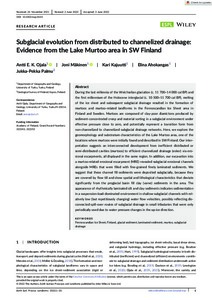Subglacial evolution from distributed to channelized drainage: Evidence from the Lake Murtoo area in SW Finland
Ojala Antti EK; Mäkinen Joni; Kajuutti Kari; Ahokangas Elina; Palmu Jukka-Pekka
Subglacial evolution from distributed to channelized drainage: Evidence from the Lake Murtoo area in SW Finland
Ojala Antti EK
Mäkinen Joni
Kajuutti Kari
Ahokangas Elina
Palmu Jukka-Pekka
WILEY
Julkaisun pysyvä osoite on:
https://urn.fi/URN:NBN:fi-fe2022081154883
https://urn.fi/URN:NBN:fi-fe2022081154883
Tiivistelmä
During the last millennia of the Weichselian glaciation (c. 11 700-14 000 cal BP) and the first millennium of the Holocene interglacial (c. 10 500-11 700 cal BP), melting of the ice sheet and subsequent subglacial drainage resulted in the formation of murtoos and murtoo-related landforms in the Fennoscandian Ice Sheet area in Finland and Sweden. Murtoos are composed of clay-poor diamictons produced by sediment-concentrated creep and material sorting in a subglacial environment under effective pressure close to zero, and potentially represent a transition form from non-channelized to channelized subglacial drainage networks. Here, we explore the geomorphology and substratum characteristics of the Lake Murtoo area, one of the locations where murtoos were initially found and described in SW Finland. Our interpretation suggests an interconnected development from inefficient distributed or semi-distributed cavities (murtoos) to efficient channelized drainage (esker) via erosional escarpments, all displayed in the same region. In addition, our excavation into a murtoo-related erosional escarpment (MRE) revealed subglacial erosional channels alongside MREs that were filled with fine-grained finely laminated sediments. We suggest that these channel fill sediments were deposited subglacially, because they are covered by flow till and show spatial and lithological characteristics that deviate significantly from the proglacial basin fill clay (varve) sediments in the area. The appearance of rhythmically laminated silt and clay sediments indicates sedimentation in a suspension-load-dominated environment in shallow subglacial channels with relatively low (but repetitiously changing) water flow velocities, possibly reflecting disconnected spill-over routes of subglacial drainage in small tributaries that were only periodically used due to water pressure changes in the up-ice direction.
Kokoelmat
- Rinnakkaistallenteet [27094]
